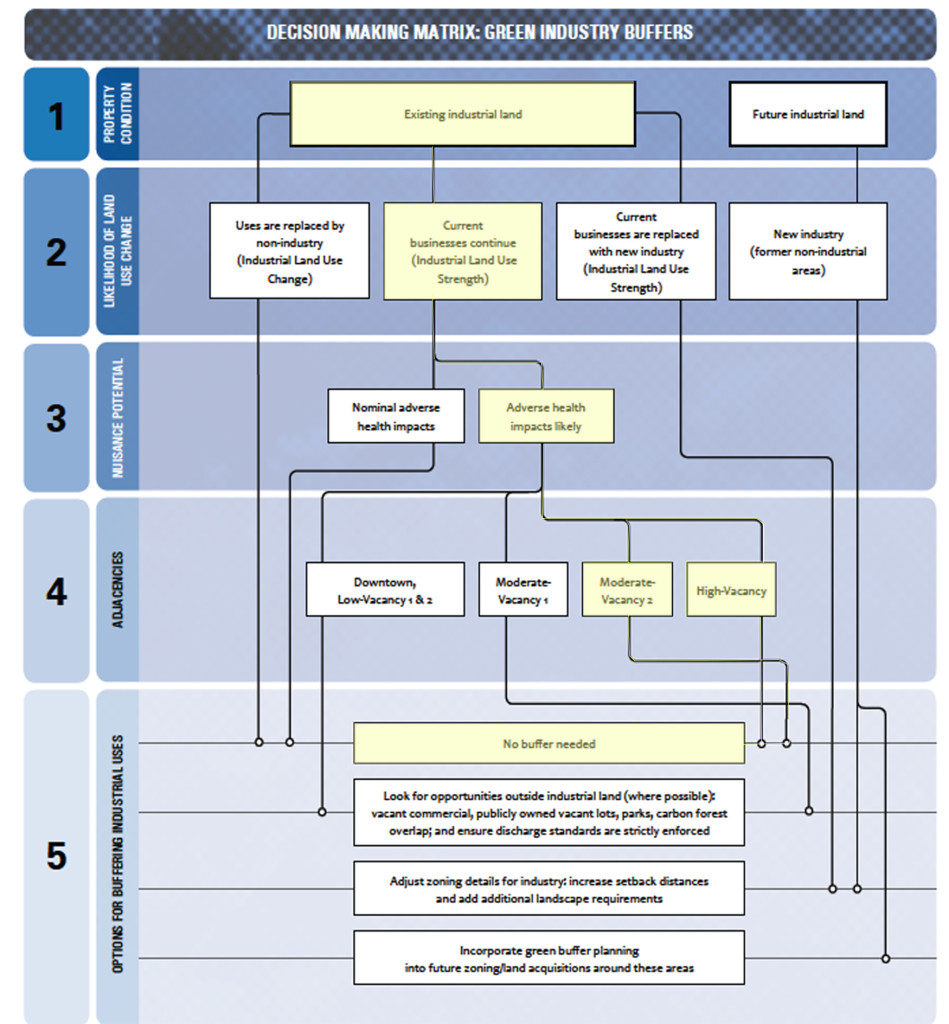Click here to view the Detroit Environmental Agenda suggestions to Detroit Future City

SEE FULL TEXT BELOW:
SUGGESTIONS FOR DETROIT FUTURE CITY
Detroit Future City has developed a thoroughly researched guide for reform and investment in making our city more efficient, green, and livable. The Detroit Environmental Agenda suggests five priorities that must happen to ensure that DFC is implemented in a manner that upholds environmental justice and sustainability.
1. Establish a clear, transparent structure for coordinating neighborhood planning processes, the City’s 2009 Master Plan, and the Detroit zoning ordinance and map with Detroit Future City recommendations.
The Detroit Future City’s 50-year land use vision and framework analysis map provide citywide guidelines within which neighborhood planning efforts must determine local priorities, especially in moderate or high-vacancy residential areas that are envisioned for radically different uses. Significant steps have been taken by the Detroit Planning and Development Department (PDD) to partner with CDAD Neighborhood Revitalization Strategic Framework Pilot areas and LISC Sustainable Communities pilots to develop a process for officially adopting community-driven neighborhood plans into the City’s master plan. PDD has also convened a small stakeholder working group to develop a guide to community planning. The City of Detroit has an important, publicly accountable role to play in leading these efforts, and should be supported by Detroit Future City.
– See page 106 of DFC: Framework Zones Map
– See page 119 of DFC: 50-Year Land Use Scenario Map
– See page 145 of DFC: Blue and Green Infrastructure Map
– See page 149 of DFC: Neighborhood Planning Reform
2. Partner with environmentally distressed neighborhoods near heavy industry to develop a plan to protect residents while encouraging economic growth.
There are several residential neighborhoods adjacent to land zoned for heavy industry; these areas are often high vacancy, but with a large percentage of homes owned free and clear by occupants. The Detroit Future City framework recommends taking advantage of the existing infrastructure and logistical assets of industrial zones to expand industrially zoned land for economic growth.
– See page 48 of DFC: Primary Employment Districts (Southwest-Industrial) Map
Later in the document, it also outlines a decision-making matrix for locating industrial-pollution buffers. The matrix states that industrial buffers are not needed for highly vacant residential areas near existing industry. This recommendation should be further assessed with the participation of affected communities.
– See page 303 of DFC: Decision Making Matrix: Green Industry Buffers (shown on right)
3. Relatedly, there are strong recommendations to streamline the City’s regulatory framework, such as permitting processes, to encourage more investment in Detroit.
There is no question that we need more efficient and business-friendly policies. However, decision-makers must make special effort to protect natural resources and public health in making these reforms; improved efficiency should not mean lax regulation. This is important, because behind-the-times zoning has left communities like Delray and 48217 in polluted limbo adjacent to deeply vested heavy industry, and unclear liability has delayed the completion of the east RiverWalk at the former Uniroyal site, which was left heavily contaminated for decades.
– See page 30 of DFC: 21st Century Regulations
– See page 147 of DFC: Enact Innovative Regulatory Reform
– See Data Driven Detroit’s TRI Air Emissions and Housing Condition Map (shown on right)
4. Green up solid waste management. Through recycling, composting, and reducing waste in general, we have the opportunity to reduce service costs and improve our city infrastructure systems.
The Detroit Future City plan errs by assuming that the City bears responsibility for the continuing operation of the incinerator at I-94 and I-75. DFC and the City should prioritize alleviating the environmental justice burden the surrounding community bears in hosting the incinerator.
– See page 198 of DFC: Reduce Waste and Increase Recycling-Incinerator Recommendation
5. Minimize demolition waste by aggressively supporting construction.
Detroit Future City implementation will require unprecedented levels of demolition; much of it will be city-owned buildings. Detroit Future City must ensure that the much-needed takedown of dangerous abandoned buildings maximizes waste diversion through salvage, reuse, and recycling. Currently, 60% to 80% of Detroit’s waste is from demolition, most of which goes to the landfill. We can reuse or recycle C&D waste; for example, San Francisco recycles over 80% of all construction and demolition waste.
– See pages 244-45 of DFC: Urban Green Neighborhoods Today/in 50 years
– See page 269 of DFC: Public Land Ownership by Vacancy
The icons on this map represent Detroit’s on-site emissions ranked by hazard level (lbs x toxicity).
The top 4 in hazardous emissions are Edw. C. Levy Co. (produces steel furnace slag), Marathon Petroleum Co. Oil Refinery, and Magni Industries in District 6, and the GM Detroit-Hamtramck Assembly Center in District 5.



